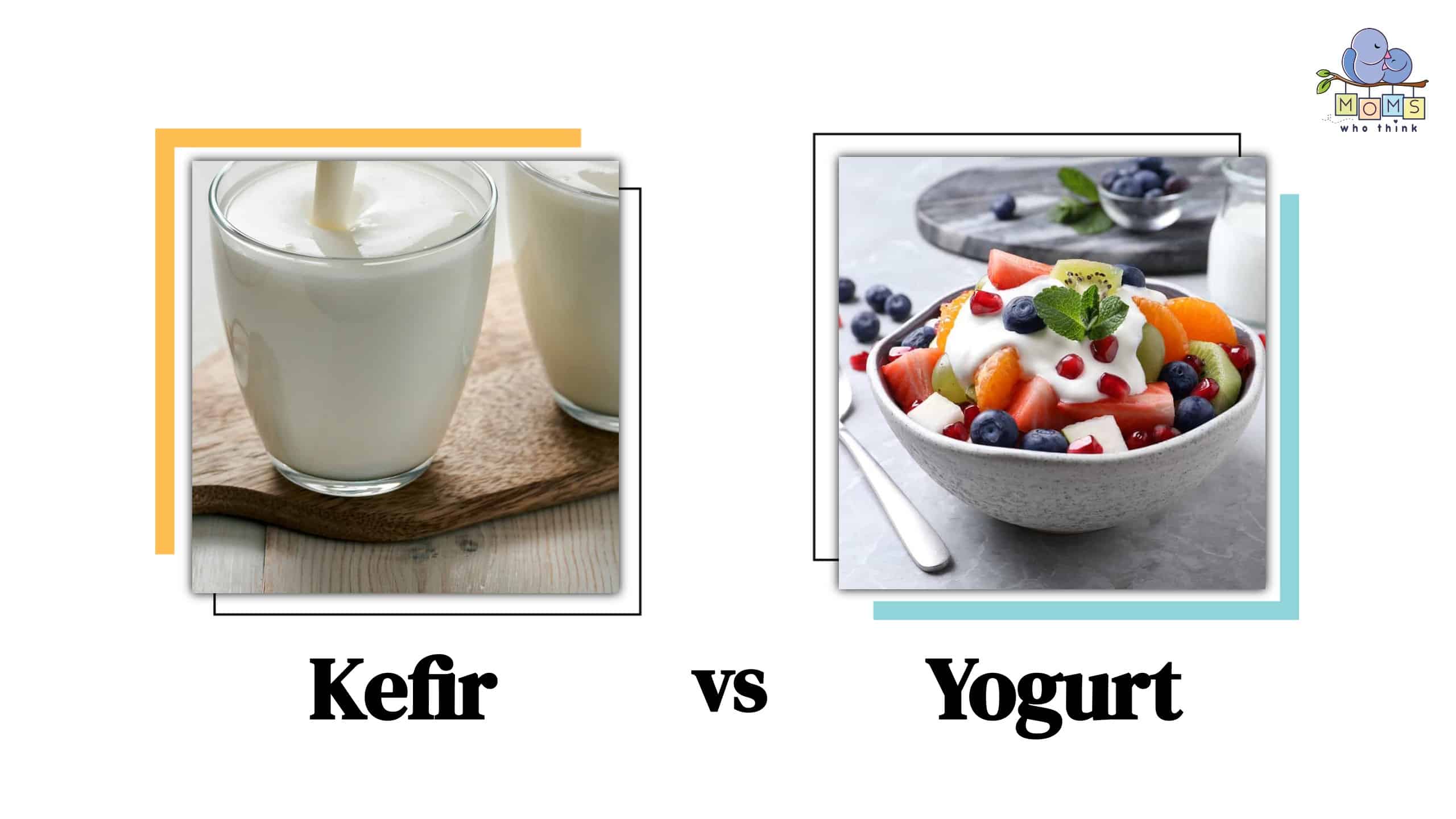Because kefir and yogurt are both fermented milk products, it's simple to mistake them for one another. Some people may even use terms like “kefir yogurt,” but they are two entirely distinct things made in entirely different ways.
There are two primary types of probiotic dairy products to choose from: kefir and yogurt. So, which is superior?
Kefir and yogurt are both products of milk fermentation, which results in the development of beneficial bacteria, yeasts, and microbes in the gut. While yogurt is more well-known and generally available, kefir is now available in nearly all major supermarkets and health food stores.
The two have many similarities, such as providing probiotics as well as calcium, protein, potassium, and B vitamins; however, their production, and thus their probiotic diversity and counts, differ slightly for reasons we'll discuss further below when comparing kefir vs. yogurt.
What is Kefir?
Kefir is a fermented dairy product created by combining kefir grains with milk. Kefir grains are a gelatinous substance formed by bacteria and yeast that resembles small grains. When kefir grains are added to milk and allowed to ferment, they devour the lactose in the milk, producing lactic acid and carbon dioxide, giving kefir its distinctive tangy and slightly effervescent flavor.
You can make kefir with a range of milk, such as cow's milk, goat's milk, and sheep's milk, as well as non-dairy alternatives such as coconut milk or almond milk. You can also use plain water! It is commonly consumed as a beverage, but it can also be used as a buttermilk or yogurt substitute in cooking and baking.
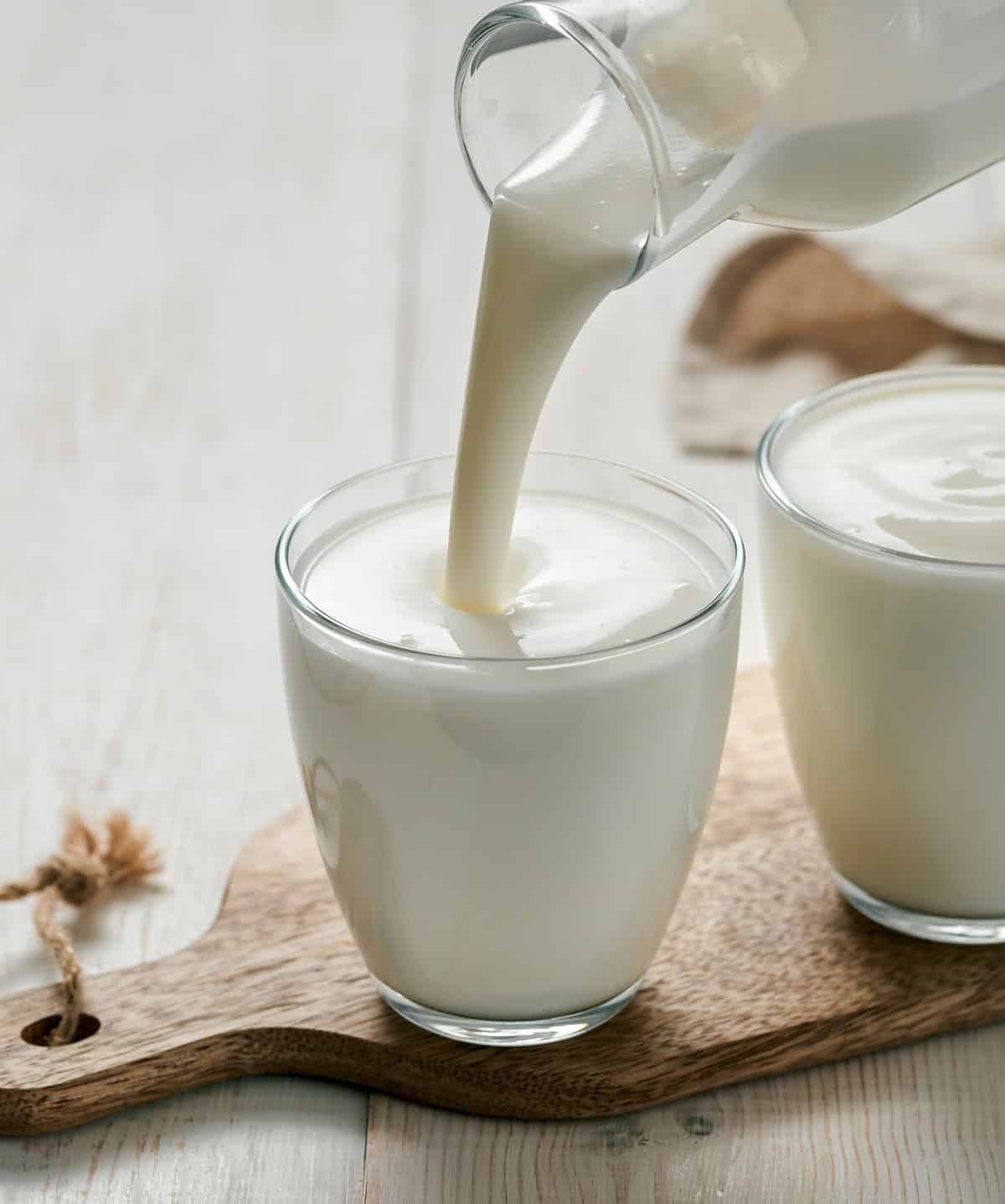
One of the main differences between kefir and yogurt is their consistency.
©Fascinadora/Shutterstock.com
Kefir is high in probiotics, which are beneficial bacteria that support gut health, digestion, and immune system function. It's also high in protein, vitamins, and minerals like calcium, magnesium, and vitamin B12. Because the lactose in the milk is not present after the fermentation process, some people with lactose intolerance may find that they can handle kefir better than regular milk.
What is Yogurt?
Yogurt is a cultured dairy product created by infusing milk with live bacteria cultures. The bacteria consume the lactose in the milk, producing lactic acid, which thickens and sours the milk, giving it its distinctive tangy taste and thick, creamy texture.
Yogurt can be made from a variety of milk such as cow's milk, goat's milk, and sheep's milk, as well as non-dairy alternatives such as soy milk, almond milk, or coconut milk. For taste, some yogurts may contain added sugar or fruit.
Yogurt contains probiotics, which are beneficial bacteria that can improve digestion and strengthen the immune system. It is also high in protein, calcium, and vitamin D. Because the lactose in milk is consumed during the fermentation process, some people with lactose intolerance may discover that they tolerate yogurt better than regular milk.
Yogurt is a versatile food that you can use on its own or used as a substitute for sour cream or buttermilk in cookery and baking. It's also popular in smoothies, dips, and condiments.

Yogurt is a widely popular dessert, breakfast, and snack food item, consumed by people of all ages.
©Africa Studio/Shutterstock.com
Kefir vs. Yogurt: The 3 Main Differences
While kefir and yogurt are both fermented dairy products, there are important differences in their bacterial cultures and consistency. Kefir contains a wider variety of beneficial bacteria and yeasts, making it a more potent probiotic. Yogurt, on the other hand, is thicker and creamier due to the specific strains of bacteria used in its production. Ultimately, the choice between kefir and yogurt comes down to personal preference and health goals.
Strains of Bacteria
Lactobacillus bulgaricus and Streptococcus thermophilus are the two bacterial strains that are typically used to make yogurt. These bacteria collaborate to ferment the lactose in milk, making lactic acid and giving yogurt its distinctive sour flavor and thick, creamy texture. Some yogurt products may also contain other types of bacteria, such as Lactobacillus acidophilus and Bifidobacterium lactis, to boost their probiotic content.
Kefir, on the other hand, is produced using a distinct strain of bacteria and yeast. Because kefir grains contain a diverse community of microorganisms, the precise strains can differ. Lactobacillus kefiranofaciens, Lactobacillus kefir, and Streptococcus thermophilus are among the bacteria usually present in kefir. Saccharomyces kefir and Kluyveromyces marxianus are two yeast species found in kefir. These bacteria and yeast collaborate to produce lactic acid and carbon dioxide by fermenting the lactose in milk.
Texture
The viscous and creamy texture of yogurt is caused by the coagulation of milk proteins during fermentation. Lactic acid is produced by the bacterial strains used in yogurt fermentation, which lowers the pH of the milk and causes the proteins to coagulate and create a solid gel. This is what gives yogurt its distinctive smooth and spoonable feel.
Kefir, on the other hand, is thinner and easier to spread than yogurt. This is because the bacteria and yeast strains in kefir do not produce the same type of protein coagulation as those found in yogurt. Kefir ferments at room temperature, allowing the microorganisms to multiply and create carbon dioxide, resulting in a slightly effervescent texture. Kefiran, a polysaccharide produced by some of the bacteria in kefir, may also be present in trace quantities, giving it a slightly slimy texture.
Kefir has a thinner and more drinkable texture than yogurt, as well as a slightly effervescent character. Some people prefer yogurt's thicker, creamier texture, while others prefer kefir's lighter, more refreshing structure.
Taste
The lactic acid generated by the bacterial strains used in yogurt fermentation gives it a tangy and sour flavor. The flavor of yogurt can vary based on the milk and the bacterial strains used, and the length of the fermentation process. For taste, some yogurts may contain added sugar or fruit.
Kefir has a slightly sour and tangy flavor that is similar to yogurt but with a slightly effervescent, slightly carbonated character. Kefir's flavor can also vary based on the milk used and the specific strains of bacteria and yeast present in the kefir grains. Some kefir enthusiasts describe it as slightly “yeasty” or “earthy”, while others find it invigorating and slightly sweet.
Benefits
Because of the different types of bacteria and yeast found in each, kefir and yogurt have varied potential health benefits. Here are some of the main differences:
Probiotic Strains
Both kefir and yogurt contain probiotics, which are beneficial bacteria that can support a healthy gut microbiome. Kefir, on the other hand, usually contains a wider variety of probiotic strains than yogurt. Kefir is superior to yogurt because it contains more probiotics. This means you'll get more healthy bacteria in smaller portion sizes. A portion of most yogurt contains about 1-1.5 billion cultures or less. Kefir, depending on the brand, includes anywhere from 10-100 billion. This may give kefir an advantage when it comes to supporting gut health and immune function.
Minerals
Kefir is a great source of the minerals potassium and magnesium, as well as phosphorous, folate, calcium, and vitamins C, D2, and K, folate. One cup of low-fat cow's milk kefir with no added sugar includes only 2 g of total fat and only 110 calories. Yogurt is high in calcium, a nutrient required for strong bones. It also contains a lot of B vitamins, calcium, potassium, and magnesium. Unfortunately, yogurt does not contain vitamin D3 naturally, but it is frequently fortified.

Both kefir and yogurt are packed with nutrients, making them an ideal food for pregnant women and young kids.
©Dmitry Melnikov/Shutterstock.com
Lactose digestion: Kefir may be more effective at breaking down lactose, the natural sugar found in milk, than yogurt because it contains a broader range of bacteria and yeast strains. It may be an excellent choice for people who are lactose intolerant because of this.
Inflammation: Some research suggests that kefir may have anti-inflammatory properties, which may help lower the risk of chronic diseases such as heart disease, diabetes, and cancer. The precise mechanisms underlying these potential benefits are still unknown.
Cholesterol: Nutritionists have suggested that kefir may help lower LDL (“bad”) cholesterol levels, whereas yogurt may not. However, experts are yet to agree on this claim.
Overall, kefir and yogurt both have possible health benefits and can be included in a healthy diet. The specific benefits of each, however, may differ based on the individual and their specific health needs.
Nutrition Comparison Between Kefir and Yogurt
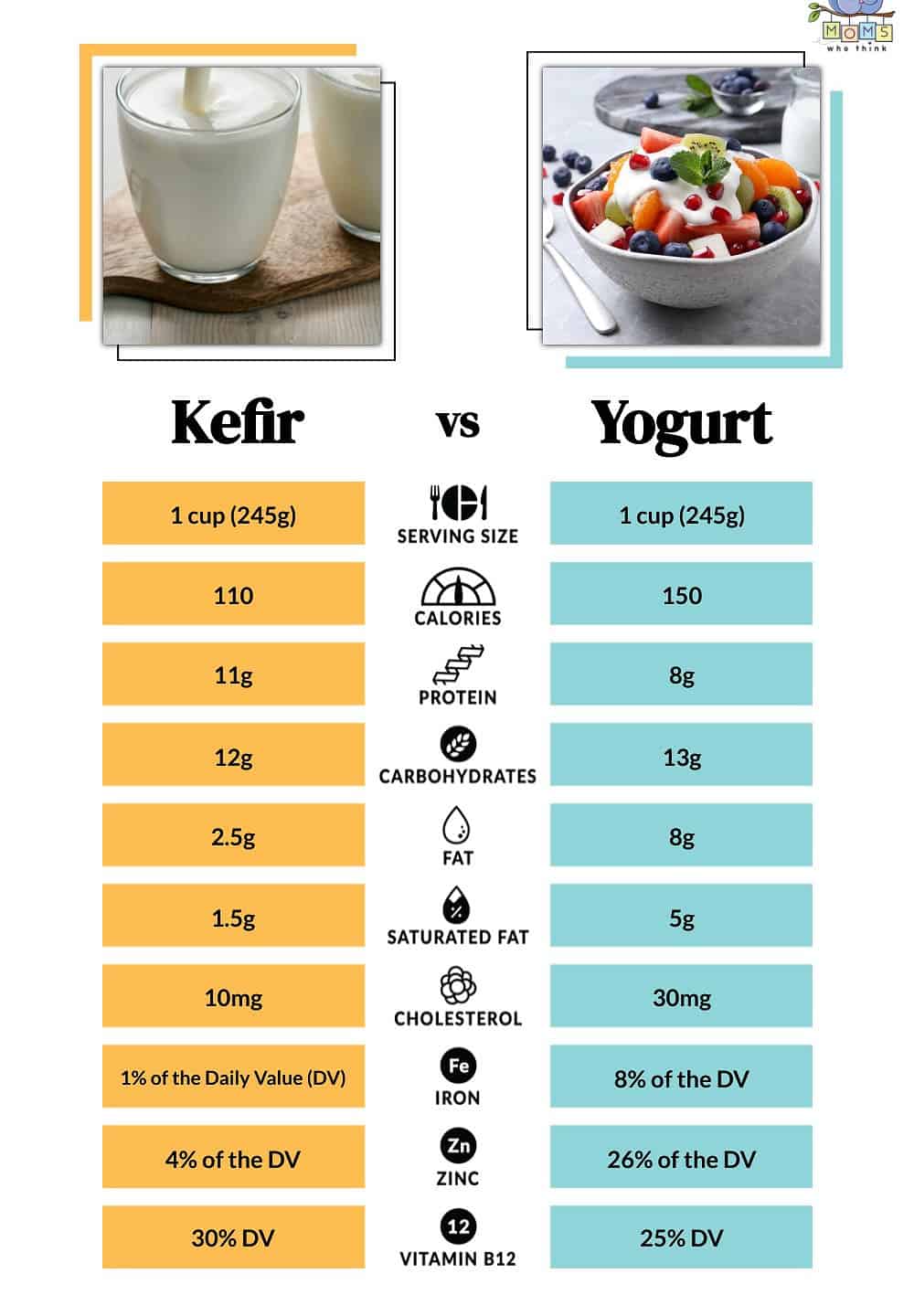
Nutritional differences between kefir and yogurt
©
Generally, yogurt has a higher fat content and more calories than kefir. However, keep in mind that there are many kinds of yogurts sold at stores. Fat content can vary and adding different flavors can also add sugars to packaged yogurts.
Can You Make Them at Home?
Yes, with the proper ingredients and equipment, you can make kefir and yogurt at home.
Yogurt
To create yogurt at home, you'll need a bacteria culture (also known as a “yogurt starter”) and milk. You can use any type of milk, such as cow's milk, goat's milk, or plant-based milk such as soy or almond milk. You will need a thermometer, a pot, and a yogurt maker or other warm setting to incubate the yogurt. The fundamental method entails heating the milk to a specific temperature, cooling it, adding the yogurt culture, and incubating it for several hours until it thickens and becomes tangy.
Kefir
To make your delicious kefir at home, you will need kefir grains as the main ingredient. These are small, gelatinous clusters of bacteria and yeast that will ferment the milk. Kefir grains are available online or at health food shops. You'll also need milk (or water if you're creating water kefir), a glass jar, and a breathable cover, such as a cloth or coffee filter. The fundamental procedure is to combine the milk and kefir grains in a jar, cover it, and leave it to ferment at room temperature for 12-24 hours. During this period, the kefir will thicken slightly and become effervescent.
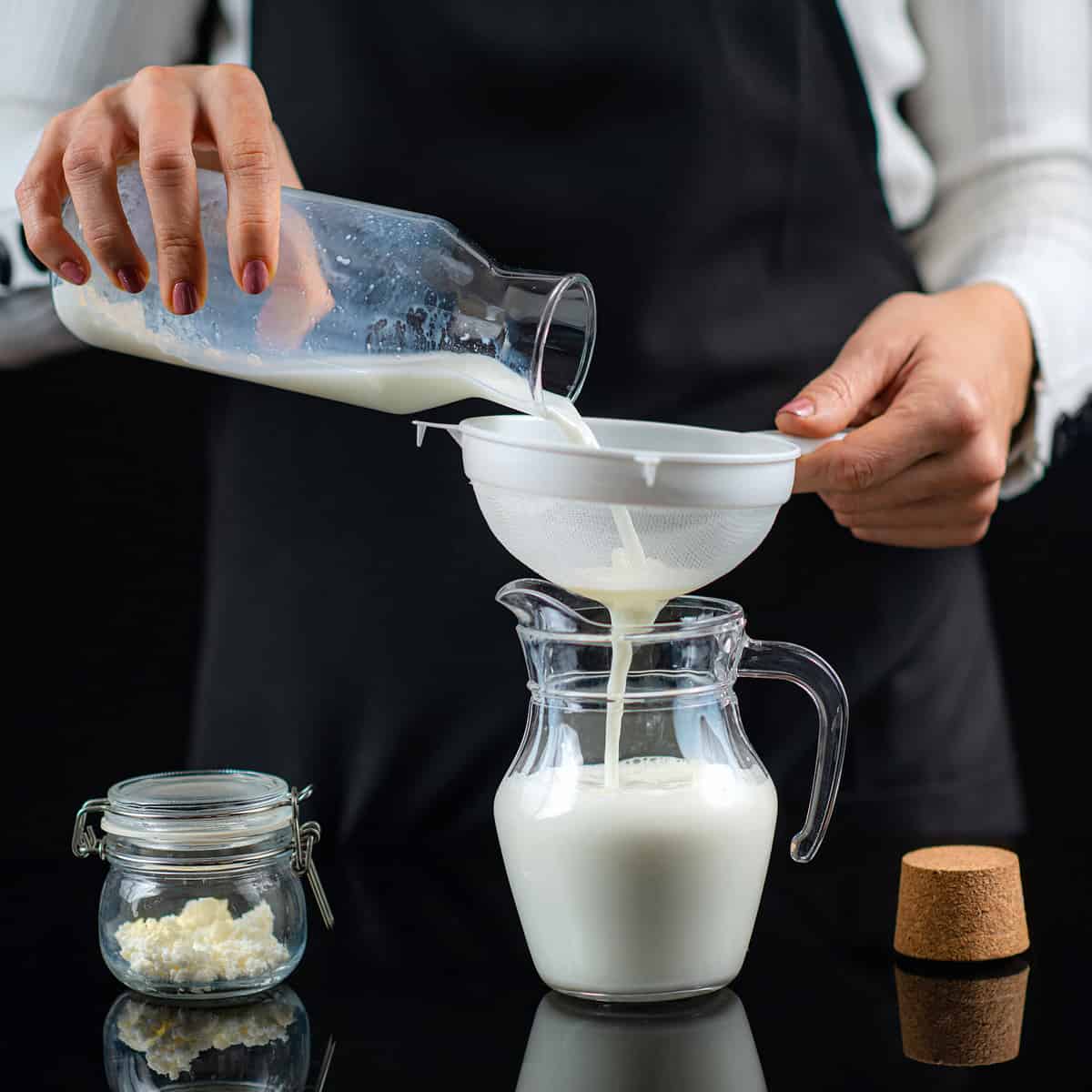
With the right ingredients, equipment, and enough patience, you can make your yogurt or kefir at home!
©Microgen/Shutterstock.com
You can tailor the ready yogurt and kefir to your tastes by using various kinds of milk or by adding sweeteners, fruit, or other flavors. Making your yogurt or kefir at home can be a rewarding way to experiment with fermentation while reaping the possible health benefits of these cultured foods.
How to Use Kefir
Kefir is a versatile ingredient that you can use in a variety of recipes, besides being a healthy and tasty beverage. Here are some ideas for how to use kefir:
- Drink it straight: Kefir can be consumed as a liquid on its own. Simply shake the container vigorously before pouring it into a glass.
- As a smoothie base: Kefir can be used as a smoothie base. For a healthy and refreshing drink, blend it with fruits and veggies.
- In baking: When baking your favorite sweet treats, you can use kefir in place of buttermilk or yogurt. You can also substitute kefir in place of milk in dishes.
- As a marinade: When you use kefir as a poultry marinade, its probiotics will serve to tenderize and flavor the meat.
- As a salad dressing basis: You can use this probiotic as a salad dressing base. To make a nutritious and flavorful dressing, combine it with herbs, lemon juice, and olive oil.
- Use it as a dip basis: Combine it with herbs and spices to make a healthy and tasty dip.
- Make overnight oatmeal: Use kefir as a liquid in overnight oats for a tangy twist on this classic breakfast meal. Simply combine it with oats, chia seeds, and your preferred toppings for a quick and nutritious breakfast.
Remember to always keep kefir in the refrigerator and mix well before using. Enjoy!
How to Use Yogurt
Yogurt, like kefir, is a nutrient-dense food that you can use as a versatile ingredient in a variety of recipes around the globe. Here are some popular uses for yogurt:
- As breakfast: Consume a serving of yogurt on its own or serve with fruit, granola, or other toppings for a healthy and filling breakfast. You can also blend yogurt with your favorite fruit for a healthy any-time smoothie.
- In dips: To use yogurt as a dip foundation, combine it with herbs, seasonings, and other ingredients to make a flavorful and nutritious dip.
- As a marinade: Try using yogurt as a poultry marinade. The acidity of the yogurt serves to tenderize and flavor the meat.
- As a healthier alternative to sour cream: Yogurt can be used in recipes in place of sour cream.
- As a dessert: Yogurt can be given as a dessert after being sweetened with honey, fruit, or other natural sweeteners.
- In salad dressings: You can use yogurt as a salad dressing base. To make a nutritious and flavorful dressing, combine it with herbs, lemon juice, and olive oil.
- As a healthier alternative to mayonnaise: Yogurt can be used in dishes in place of mayonnaise.
For the healthiest choice, choose plain, unsweetened yogurt. Refrigerate at all times and consume within a week of opening.
Possible Side Effects
While probiotics are beneficial to the digestive system, they can trigger allergic reactions in some people.
- One of the kefir’s side effects is caused by a histamine substance, which is also present in yogurt. In some individuals, histamine can trigger skin irritation, headaches, and diarrhea.
- You may also experience the very symptoms that probiotics combat: flatulence, bloating, constipation, and diarrhea!
These effects are typically transient as a result of rapidly increasing gut probiotics.
To reduce these negative side effects, gradually increase your probiotic intake to enable your body to adjust to its new diet.
- Fermented foods can cause food poisoning in rare instances if prepared incorrectly. This is so uncommon that it is hardly cause for concern beyond the usual precautions. You should take to ensure the foods we consume are safe and within their expiry date.
- Probiotics can have different effects on people who have seriously compromised immune systems. Consult a doctor if your immunity lies in this category to guarantee that taking yogurt or kefir is safe for you.

A glass of probiotic milk is good for a child's healthy growth.
©ZouZou/Shutterstock.com
Conclusion
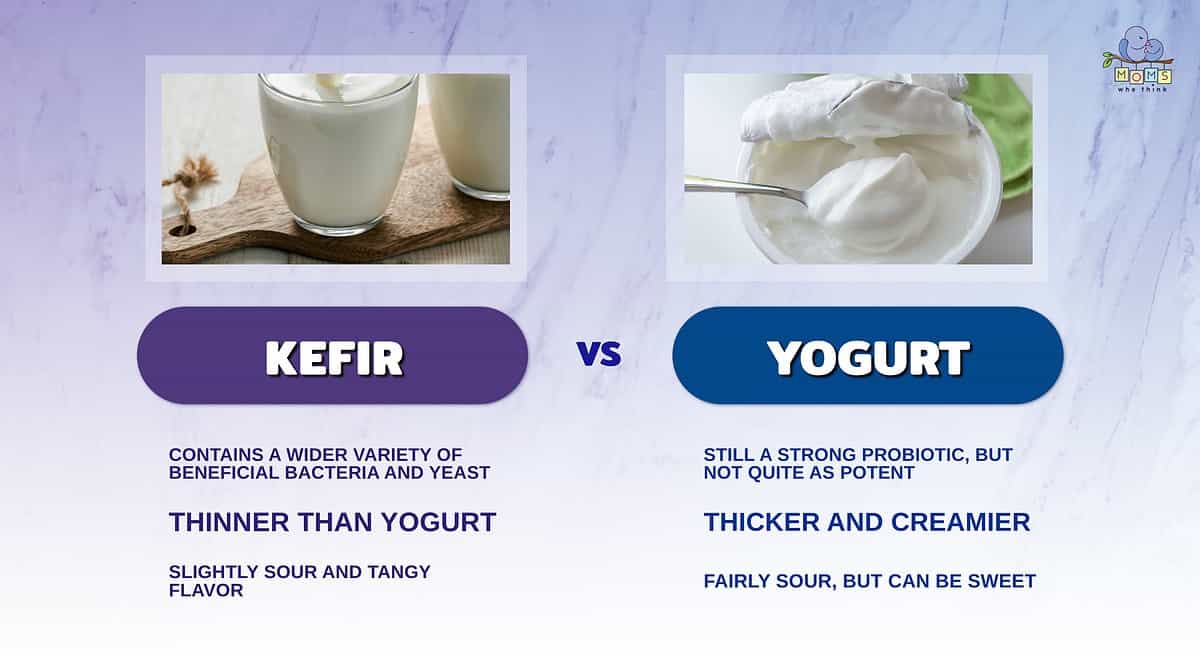
- Kefir contains a wider variety of beneficial bacteria and yeast, making it a stronger probiotic than yogurt. This makes it a great choice for promoting digestive health.
- Yogurt is thick and creamy, while kefir is thinner and more drinkable.
- The flavor of kefir tends to be slightly sour and tangy. Yogurt tends to be fairly sour, but is often sweetened with sugar. It's important to look at the nutrition label of yogurt to see how much added sugar is in it.
Probiotics are an excellent way to improve your gut health. Besides kefir and yogurt, other excellent probiotic foods include buttermilk, pickles, miso, tempeh, sauerkraut, kombucha, and kimchi.
Healthy digestion may contribute to a healthier life in general. It makes no difference whether you choose yogurt over kefir or probiotic supplements instead. Each provides numerous advantages when you buy or create kefir and yogurt as naturally as possible. Choosing without added sugar, artificial flavors, or other bad-for-your-gut ingredients.
Still on the hunt for a good recipe to use yogurt in? We've got another one from our recipe book for you to try:
Print
Greek Yogurt Blueberry Smoothie
Ingredients
- 1 Blueberry Greek Yogurt
- 1 cup Frozen Berries
- 3/4 cup water or milk
- 1/2 Banana
- Honey to taste (optional)
- Optional Protein additions: Chia Seeds, Oatmeal, Peanut Butter, or Almonds
Instructions
- Combine ingredients and blend.
